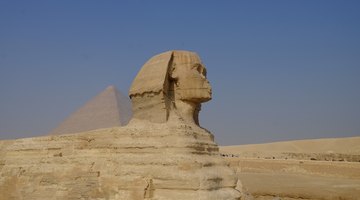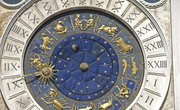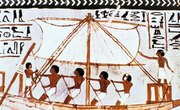Ancient Egyptian society used different forms of money before using coinage in the first millennium B.C. The Egyptians used non-coin forms of silver and gold currency, such as silver rings and gold pieces shaped like sheep, centuries before minting coins out of the metals. The earliest forms of money in Egypt were not based on metals, but rather based on a barter exchange of everyday goods.
Grain Banks
Ancient Egyptian governments centralized harvests in state warehouses. Grain harvesters would deposit their grain into the central warehouses for security and convenience. The depositors could then withdraw a particular lot of grain when they wanted to make a purchase. Sometimes the deposits into these Egyptian grain banks were voluntary and other times it was required by the king. Written orders for grain withdrawal could be used to pay tax collectors, priests and merchants.
Barter System
Ancient Egyptian society practiced a complex barter system of cashless exchange. People would gather in public marketplaces to exchange their goods with one another. Some marketplaces were seasonal and included valuable and unique products that were produced outside of the local area. Beginning in the first millennium B.C., according to the Tehuti Research Foundation, metal coins were used in ancient Egypt to correct for small differences in value during bartering transactions. Coins were also used for highly complicated transactions, such as business transactions.
Metal Weights
Before they started using coins around 500 B.C., Egyptians used a system of value based on the weights of various metals, especially silver and copper. According to the British Museum, records from the 18th dynasty (1550-1295 B.C.) reveal that the metals themselves were not exchanged between people at that time even though they were used to determine the value of other things. Silver became such an important metal used as money that the Egyptian word for silver, “hedj,” eventually came to mean “money.”
Bread and Beer
Bread and beer were currencies used by less wealthy Egyptians. Subsistence workers in ancient Egypt were sometimes paid in bread and beer because they were staples of the Egyptian diet. Bread and beer acted as rations to feed poor workers, although there are cases in the Middle Kingdom of highly paid workers earning several hundred loaves of bread per day. Uniformity of value was important in the bread and beer currency, with standard sizes for beer jars and bread loaves baked from a standard recipe with uniform nutritional value.
Related Articles
References
Writer Bio
Brian Gabriel has been a writer and blogger since 2009, contributing to various online publications. He earned his Bachelor of Arts in history from Whitworth University.











